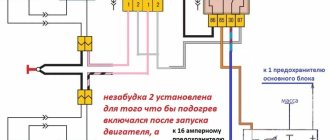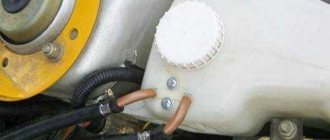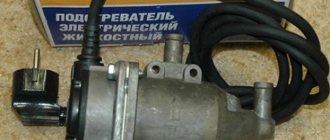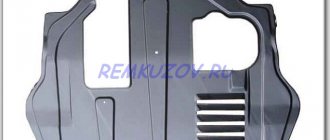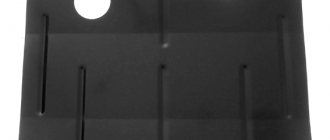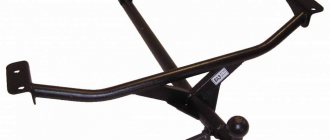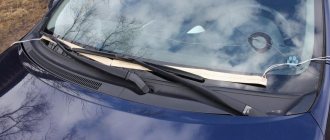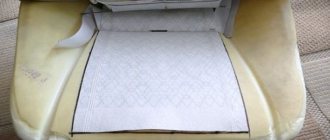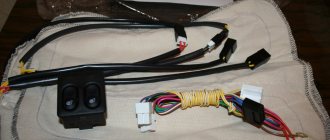When in severe cold you have to get behind the wheel of a VAZ 2110, and you feel it with your back and with the ones below you. the seat is cold, you can’t help but think that it wouldn’t hurt to have heated seats in the car. The fact is that standard heated seats on the VAZ 2110 are found only in the luxury version of the last years of production, and in all other cars of this series heating is not provided. However, you shouldn’t despair, because anyone can do independent repairs and connect heating.
Block of buttons for heated seats VAZ 2110 pinout
Today we will look at the location of fuses in VAZ cars of the tenth family, namely models 2110, 21102, 21103, 2111, 2112. We will also show where the fuses and relays are located on the diagram and talk about the purpose of each of them and how to replace the fuses with your own hands.
We will also touch on the most common problems with fuses among owners of these cars, diagnostic methods and replacement. I would like to say that car electrical systems, in particular fuses and relays in the VAZ 2110, 21102, 21103, 2111, 2112, are quite reliable. The service life depends on operating conditions and timely diagnosis and replacement with high-quality components.
Let's figure out why fuses are needed in a car. First of all, they are responsible for the safety of the wiring and other systems of the machine. It is important to understand that each specific fuse is responsible only for its task and in the event of a short circuit or failure, a fire is practically excluded. A specific fuse blows and this does not cause a chain failure of other systems.
Depending on the problem of failure of any component or part of the car for which the electrician is responsible, you need to understand whether the car can be operated with this malfunction or not. The traffic rules contain a list of faults that you cannot operate a car with. If you discover, for example, that the headlights have failed or the wipers are not working at all, you should immediately correct the problem. Well, you can drive a car with non-working power windows. So…
Fuse connection diagram
The figure below shows the order of connecting the plugs in the mounting block.
Drawing of connecting the plugs to the corresponding blocks of the mounting block.
The figure below shows a complete diagram with mounting block symbols.
From this diagram it is not difficult to figure out the order in which the plugs are connected.
- K1 - serviceability of lamps,
- K2 - windshield cleaner,
- K3 - turn signals, emergency lights,
- K4 - low beam,
- K5 - high beam,
- K6 - additional relay,
- K7 - heated rear window,
- K8 is an unused relay on VAZ models of the tenth family.
Video on removing the unit and replacing fuses
Dismantling works
To install heating elements, you first need to carry out a dismantling procedure. It includes the following activities.
- Unscrew the plastic fasteners that connect the seats to the body of your car.
- Remove the skids. Two pieces are located in front, and two more are located in the back.
- Remove the chairs from the interior, otherwise it will be extremely uncomfortable to work.
- Separate the back from the chair. To do this, there are bolts on the sides, which can be removed with a 10 mm wrench.
- On the back there is a plug for the headrests, which can be removed.
- The upholstery is removed from the hooks below. To do this, the hooks are slightly unbent.
- Now you can completely remove all the trim.
- Carry out a similar procedure with the second seat if you plan to install heating on it too.
While you are installing the heating, throw the upholstery into the washing machine. This will not harm her, and the interior will look newer and nicer.
Installation of heating elements
Many people forget about the need to securely fix the elements responsible for heating the seats. As a result, over time they can shift, thereby disrupting the performance of the system.
To avoid such situations, experts advise sewing heating elements directly to the inside of the upholstery. Although today some car owners prefer another option, which uses double-sided tape. The elements are held on it quite reliably, and the tape is attached to the foam rubber itself.
Connection process
Regardless of the chosen fixation method, reverse assembly looks the same for all options. This is the most difficult stage, so strictly adhere to the specified sequence of operations.
- Pull the covering back onto the back, where the heating was already fixed.
- Using a mallet, the plugs are driven into place. We are talking about plugs for headrests.
- Next, the fabric is stretched. The front one is pushed through the hole, and the back one is straightened down.
- The fabric from the front is draped over the hooks and then stretched. Just watch the degree of tension so that the fabric does not tear.
- Now you can put the rear trim element on the hooks.
- The next step is to insert the wire into the front and tension the sheathing.
- If you plan to change the foam rubber, cut out the new elements in strict accordance with the dimensions of the old material.
- Pay attention to the areas where the spring contacts the body and seat ties. To avoid squeaks, use pieces from the washer tube, or simply wrap several layers of electrical tape.
- Heating for the lower part of a car seat is often mounted using double-sided tape or sewn to the trim on the inside. You can use plastic clamps or wire brackets, which will prevent the heating elements from moving from their installation locations. After this, the plastic fasteners are tightened.
- Connect the backrest and seat.
- A wire is pulled through the hole in the frame and the foam rubber, with which the heating will be connected to the on-board network.
- The wiring connection is carried out strictly according to the diagram. It is necessarily included with the set of heating elements, so you don’t have to look for anything additional.
- The standard location for installing heating on and off buttons is the area near the handbrake. Although you can place them as you wish.
- It’s not uncommon for car owners to take an alternative route, installing a standard heating system on top of the seats, after which they put car covers on top.
There is a modern and very simple solution - heated capes that can be put on in winter and removed during warm periods. Their disadvantage is that the wire runs freely, which can interfere with the driver. Plus the capes do not fit tightly to the chairs.
Option with capes
Installation of heating elements
To ensure that the installation of heating in the future is not complicated by the shifting of the elements, and the repair brings warmth in the literal sense of the word, it is best to sew the heating elements directly to the upholstery from the inside. But craftsmen also use other methods, for example, double-sided tape, which is used to glue the heating directly to the foam rubber of the seats.
The following is the assembly:
- You need to pull the covering over the back with the heating already attached;
- Hammer the headrest plugs with a mallet;
- Stretch the fabric: simply straighten the back one down, and push the front one through the gap;
- Place the front fabric over the hooks, pulling it taut but not too tight;
- Then place the back of the trim on the hooks;
- Insert the wire into the front part and tighten the casing;
- If your renovation involves replacing foam rubber, then it must be cut exactly to the measurements of the old one. And to prevent creaking, in places where there is contact between the springs and the ties and the body, it is best to install pieces of a washer tube or another suitable one; you can also wrap several layers of electrical tape;
- The heated lower parts of the VAZ 2110 seats can also be glued to double-sided tape or sewn to the trim from the inside. And so that it does not move, you can tighten it with wire staples or plastic clamps. Then tighten the plastic fasteners;
- Attach the backrest to the seat;
- Pass the wires to connect the heating through the foam rubber and holes in the frame;
- Connect the wires according to the diagram that comes complete with heating elements for the VAZ 2110;
- Buttons for turning the heating on/off are usually mounted next to the handbrake.
It is possible to install standard heating on the outside of the seats; covers are placed on top.
There is an easier way to feel the warmth from sitting in winter - special seat covers that operate from the cigarette lighter. Their advantage is that they are easy to install/remove. The downside is the dangling wire in the cabin, and the loose fit to the seat.
Remember also that the VAZ 2110 is still not an incubator, and there is still debate among doctors regarding whether seat heating is harmful or not for men’s health. So, just in case, don't get too carried away with it. Let the heating button be turned on before you even get behind the wheel.
Dismantling works
To install heating elements, you first need to carry out a dismantling procedure. It includes the following activities.
- Unscrew the plastic fasteners that connect the seats to the body of your car.
- Remove the skids. Two pieces are located in front, and two more are located in the back.
- Remove the chairs from the interior, otherwise it will be extremely uncomfortable to work.
- Separate the back from the chair. To do this, there are bolts on the sides, which can be removed with a 10 mm wrench.
- On the back there is a plug for the headrests, which can be removed.
- The upholstery is removed from the hooks below. To do this, the hooks are slightly unbent.
- Now you can completely remove all the trim.
- Carry out a similar procedure with the second seat if you plan to install heating on it too.
While you are installing the heating, throw the upholstery into the washing machine. This will not harm her, and the interior will look newer and nicer.
Back
We hide the wires of the element in a thermal tube, thus creating a protected cable. Now the cable needs to be removed. The difficulty is that the back of the VAZ-2108 seat not only tilts back and forth, but also leans forward. This requires large cable runs - up to 10 cm. Therefore, it is necessary to provide an option for free movement of the cable. We will achieve this by running the cable in a ring at the inner end of the backrest under the upholstery: as the backrest moves, the cable ring will decrease or increase.
To fix and guide the cable, we sew a piece of fabric (sling, lace, etc.) under the upholstery with two “ears” through which the cable will be passed: a smaller “ear” - the cable from the element to the loop, a larger one - from the loop to the outlet further . We lay the cable, tilt the backrest completely back, pull out the cable, leaving a small loop - this will be the maximum length of the cable and the minimum loop. By tilting the backrest forward, we check the free movement of the cable and the change in the loop. Now you can close the upholstery.
Next, we prepare the lining of the back support. The cladding is normally secured with a screw at the bottom and a plastic clip at the top, which easily breaks and does not hold well. Here we will replace the clip with a regular screw and nut (it is more convenient to tighten them in the middle position of the backrest), for which it is enough to drill a hole in the lining, and there is already one in the support. Now we guide the cable along the stamping in the seat back support and turn it horizontally forward. We install a facing that securely fixes the cable, but leaves it free to move in the loop.
That's it with the backrest, let's put it aside for now and move on to the seat.
https://youtube.com/watch?v=VUbl0jy2rqw
Dismantling
We begin tuning and repairs with the removal and subsequent disassembly of the seats, which is carried out as follows:
- We unscrew the plastic fasteners with which the seats are attached to the body;
- Unscrew the slides (2 each in front and back);
- We take the seats out of the cabin;
- Separate the backs. To do this, you need to unscrew the bolts on the sides with a 10mm wrench;
- Directly on the bottom of the seat you need to pull out 4 plastic fasteners and remove the trim;
- On the backrest you need to remove the plugs for the headrests. Then, at the bottom, remove the upholstery from the hooks, which will require slightly straightening them. Now you can remove the casing completely.
When making such repairs, it would be very good to wash the upholstery in a regular washing machine at the same time. This will not harm her, and driving a VAZ 2110 clean is somehow more pleasant.
Hello everyone! At the beginning of last winter I installed heated seats from a VAZ-2110. The thing is cool and necessary in winter, but it has one drawback: a couple of minutes after turning it on, it starts to fry your butt, and if you turn it off in cold weather, the seat cools down instantly and also becomes not very comfortable. I decided to upgrade the control unit to eliminate these shortcomings. I used the eight-bit AVR Attiny2313 microcontroller for which the firmware was written and a board was made for installation in a standard ten-pack case. Heating is regulated using PWM: current is supplied with a constant voltage in the form of pulses, and the wider they are, and the shorter the pauses between them, the more the element heats up. The power part of each channel is made of a MOSFET transistor; the operating mode is indicated by a combination of two LEDs, red and green. The connector terminals for connection, as well as the buttons themselves, are taken from the standard unit. The unit has three heating modes: 30%, 60% and 100% of full power. Each channel operates independently of each other, the last selected operating mode is stored in non-volatile memory (EEPROM) and is selected automatically the next time it is turned on. When you turn on the heating, the intensive heating mode at full power is first switched on for a while, after which the last memorized mode is automatically switched on. The intensive heating time can be adjusted during operation; for this, when the heating is turned off, the driver's seat switch is pressed for 2 seconds, after which the unit turns on the driver's heating at full power. As soon as it starts to get hot, turn off the heating, the unit remembers the time and switches to normal mode. In the future, it will turn on exactly for this time. Each channel is indicated by two LEDs: 30% - green, 60% - yellow, 100% - red. The intensive heating mode is indicated by blinking red, the time setting mode is indicated by blinking green. I wanted to make sure that the updated unit would fit without modifications to the existing wiring, but since the installation space in the unit is very limited, I had to use the simplest circuit for connecting a power transistor, which involves controlling the load minus and the constant presence of a plus on the second load terminal, but in the standard one it was the other way around: one terminal is constantly on ground and the plus is switched. Therefore, minor wiring alterations are inevitable. Schematic diagram:
In the final version, there were minor deviations from this scheme in case of interference from the ignition, generator, etc. (MK is very sensitive to power supply interference), but practice has shown that everything works fine without them.
While working on the device I came across this solution: https://www.drive2.ru/communities/e-stuff/blog/636105 The idea and implementation are interesting, due to the fact that they abandoned the original buttons, which eat up 60% of the usable area boards, in favor of mikrikov from ordinary household equipment, we managed to free up enough space for additional wiring of the MK, but we had to collectively farm our own stands for rockers made of PCB. I hoped that it would be possible to remove the original ones and put them on a new board, but I was mistaken, the quality of their manufacture left much to be desired and they were tightly rolled on the board and I had to make one stand of the same homemade kind. I also doubted that the microphones would provide sufficient pressing force in such a design; my fears were partially confirmed in the comments on the drive. In addition, the author of the device used a more expensive microcontroller, while at the same time my experience has shown that a cheaper and more compact one is quite sufficient.
Operating principle of heated seats
At the head of the system is a heating element, which is connected to the on-board network of the machine. The parts are placed in an elastic panel and installed in the front seats. The systems are divided into two types: some are built into chairs, others are made in the form of seat covers. The mechanism of operation of both types is actually similar.
The heating elements are treated with a special coating that insulates them from direct contact with the upholstery. There are designs with one or two heating elements. The heaters are connected to the vehicle's electronic network through a control unit. Some system models allow you to adjust the temperature.
Next to the heater there is a sensor that controls heating. When the desired temperature is reached, the system turns off the power. There may also be a function for automatically maintaining the heating level, which is set by the driver. Other systems are timer controlled.
Built-in devices with 2 elements can provide rapid heating, after which the system switches to the lowest power and lowest heating. The number of modes depends on the heater model.
See:
Injection injection system
For VAZ-2110 cars (8-valve injector), the electrical circuit differs slightly from that used in carburetor cars. Injection engines are much more complex, since they have an electronic control unit and a system of sensors and actuators. It is also worth noting that injection engines come with 8 and 16 valves. There are no carburetor engines with 16 valves. All wiring can be divided into engine compartment and interior wiring.
Their purpose is clear from the name. The engine compartment connects elements such as the starter, generator, sensors on the engine, etc. Interior wiring is necessary to connect the instrument panel, backlights, and various switches.
What is needed for this?
The first thing you need to figure out is what elements, materials and tools will be useful to you during the heating installation process.
Element
Explanation
They are required for backs and seats. Experts recommend choosing the standard ones provided for the VAZ 2110. They are sold in sets for two seats. Their cost ranges from 1000 to 1400 rubles. The kit also includes wiring and buttons to turn the heating on and off.
They are not always included. They are used to turn the seat heating system on and off.
It serves to connect the heating to the vehicle’s on-board network
If the seats are already quite worn, it would not hurt to replace the foam rubber, which is short-lived
Choose only high-quality materials, purchase kits from trusted retail outlets. Heating is carried out by electricity, which is always dangerous to human life and health.
On/off buttons
Health issue
Today, medical professionals are still actively arguing about the harm of heating seats inside cars. Some believe that heating is harmful to men's health. Others, on the contrary, consider this a normal and even useful addition to the car.
The decision is yours in any case. But we recommend not to get carried away with high temperatures. Just warm up the seat a little before you hit the road. And then turn off the system.
Didn't find the information you are looking for? on our forum.
Installation of heated seats "cape"
The heated seat “cowl” fits over the cover or seat of your vehicle. Fixed on the seat with elastic bands. The heating plug is inserted into the cigarette lighter and narrower, after which the desired operating mode is selected on the heating button. Such heating is dangerous because some models do not have protection and leaving it in the cigarette lighter can lead to dire consequences.
The installation of heated seats on your vehicle is complete. Standard heating only works when the car's ignition is turned on.
We hope our article was useful to you.
Popular
Since the relay is open, turning the ignition on again leaves the heating off and you must press the button again to turn it on. I didn’t take photographs of this process - everything is done locally anyway.
When they are inserted, a toothed metal plate is clamped on top with pliers and cuts through the insulation.
How to install heated seats in a car yourself? By the way, don’t be lazy and install other heating units.
Now you can put the rear trim element on the hooks. In this case, the on-board network will not be affected if the heating fails. Experts recommend choosing the standard ones provided for the VAZ. The connection of control, indication and button illumination was carried out with a two-core wire.
We recommend: Pue frequency of grounding checks
Simple universal heated seats and a diagram of connecting it to the car
I plopped down on the icy seat for a couple of seconds, started the car, pressed the heating button, and within a couple of minutes the seat was already warm. Element Explanation Heating elements These are required for the backrests and seats.
Do you use heated seats? This arrangement of switches will be the most successful from the point of view of ergonomics and comfort. The best opportunity for self-installation of heating elements remains in cars that already have a system installed, but not installed by the manufacturer.
With a correctly assembled circuit, the heating will function only when the ignition is on. Didn't find the information you are looking for?
Bend back the cover at the passenger's feet and remove the cover of the ECU box. The ideal option is either the center console if there is space for installing buttons, or in the space between the gearbox rocker and the handbrake. This option is quite rare on budget class cars. Unclip the trim on the dashboard where the various buttons are located. INSTALLING HEATED SEATS ON A CHEVROLET NIVA WITH YOUR OWN HANDS. HOW TO CONNECT SEAT HEATING.
Heated seats VAZ 2110, 2111, 2112
The content of the article:
Heated front seats VAZ 2110
All of us, owners and users of the Premier and the last Ten, were lucky with this matter. Especially those for whom he works. Even more for those who have a late-production car with new heating elements.
All replacement activities were timed to coincide with the reupholstery of the interior seats. And since the new thing took a little longer, about two months, the installation of heating took place right at the end of January. But February was enough to evaluate the new products. Previously (back in the fall), a heating kit Emelya UK1 (Teplodom LLC) was purchased for this purpose. The task was to install Emelya UK1 to heat the front seats instead of the standard set, and transfer the latter to heat the rear ones.
Heating kit Emelya UK1.
Initial data: Heated front seats. Connected. The wiring is OK. The passenger seat heating works. Only sluggishly. You begin to feel its presence only after 15-20 minutes, that is, later than you heat the seat yourself. It fulfills its function. But it's pointless. The heating of the driver's seat is just as sluggish and only works partially: only the backrest, there is no plug from under the seat.
We consider that our chairs have already been removed, brought home, and the beer/kettle is charged.
I won’t describe this process at all, I’ll just show photos. Because, of course, at first I thought about making a full article, but later I decided that there were already a lot of them, and I wouldn’t add anything new. Everything is the same as with other lucky ones.
The back of one of the seats. The heating thread laid in a zigzag pattern is clearly visible. Only 4 pieces of thread are actively involved in heating. Later there were more of them, which increased the heating power.
In addition, the thick 8-mm standard seat upholstery prevents heat from getting through.
Front passenger seat.
Driver's seat. The heating filament is intact.
Standard heating element.
There is no need to invent anything new. Emelya is equipped with everything necessary: instructions, heating elements (4 pcs.), control unit, relay, wiring.
The operation will require tools for removing seats and upholstery from them, as well as thin double-sided tape for gluing heating elements.
In principle, you don’t have to complicate the process (depending on who knows) and change the heating elements without removing the seats. Carry out the process on the spot, just pulling the upholstery off the chairs.
If you are installing heating for the first time, then simply follow the connection diagram according to the instructions. If you are changing it, it is better to remove the old wiring, replacing it with a new one from Emelya - it is thicker, which means it is more reliable. Or you can connect the new wiring parallel to the old one (including the relay) - as I did, leaving the standard wiring for connecting the rear heating. I also did this because the old wiring is thinner than the new one, and could not withstand (and most likely would not have withstood) the power of the new heating elements (maximum power of one element is 70 W versus 40 W for the standard one).
Standard heating, installed on your car in high trim levels
This is probably the most optimal option, for example, in some foreign cars there is no heating in the “base”, although in the “high” trim levels it is. You just need to purchase and install it yourself; this can be easily done either from an official dealer or from sellers of original spare parts. I want to warn you right away - as a rule, no complicated dances with a tambourine are required, because both the fuse box and the wiring will already be installed from the factory, you just have to connect the elements themselves and thermostats.
Of course, the only difficulty will be removing the seat trim, but now you will find a lot of instructions on the forums, I think this is not a problem at all.
Next, we simply glue it onto the foam rubber and put the standard covers back on – we cut in the buttons – we run the necessary wires, and the heating is all ready. The procedure is done by hand in half a day. If you look at the money, it turns out that for two front seats, two elements cost about 3,000 – 5,000 rubles, it all depends on the class of the car + wires and buttons, that’s about another 2,000 – 3,000 rubles. Total for an ordinary foreign car of class “B – C” is about 5,000 – 8,000 rubles.
Heated seats VAZ 2110, 2111, 2112
The content of the article:
Heated front seats VAZ 2110
All of us, owners and users of the Premier and the last Ten, were lucky with this matter. Especially those for whom he works. Even more for those who have a late-production car with new heating elements.
All replacement activities were timed to coincide with the reupholstery of the interior seats. And since the new thing took a little longer, about two months, the installation of heating took place right at the end of January. But February was enough to evaluate the new products. Previously (back in the fall), a heating kit Emelya UK1 (Teplodom LLC) was purchased for this purpose. The task was to install Emelya UK1 to heat the front seats instead of the standard set, and transfer the latter to heat the rear ones.
Heating kit Emelya UK1.
Initial data: Heated front seats. Connected. The wiring is OK. The passenger seat heating works. Only sluggishly. You begin to feel its presence only after 15-20 minutes, that is, later than you heat the seat yourself. It fulfills its function. But it's pointless. The heating of the driver's seat is just as sluggish and only works partially: only the backrest, there is no plug from under the seat.
We consider that our chairs have already been removed, brought home, and the beer/kettle is charged.
I won’t describe this process at all, I’ll just show photos. Because, of course, at first I thought about making a full article, but later I decided that there were already a lot of them, and I wouldn’t add anything new. Everything is the same as with other lucky ones.
Necessary equipment
To install the heating you will need:
- Special heating elements for the backrest and the seats themselves. Preferably standard ones, for the VAZ 2110. It is also possible to install heating not only for the driver, but also for the front passenger. Then you will need two sets. As a rule, a heating kit is sold immediately with heating elements for the two front seats, i.e. only 4 pieces. The price of a standard kit for a VAZ 2110 ranges from 1100 to 1300 rubles, the kit also includes wiring and on/off buttons; Set of standard seat heating
- Buttons that will be used to turn the heating on and off;
- Wires for connecting heated seats to the on-board network of the VAZ 2110;
- Tools: screwdriver, 10mm head;
- If your seats can no longer be repaired, then buy new foam rubber for them.
